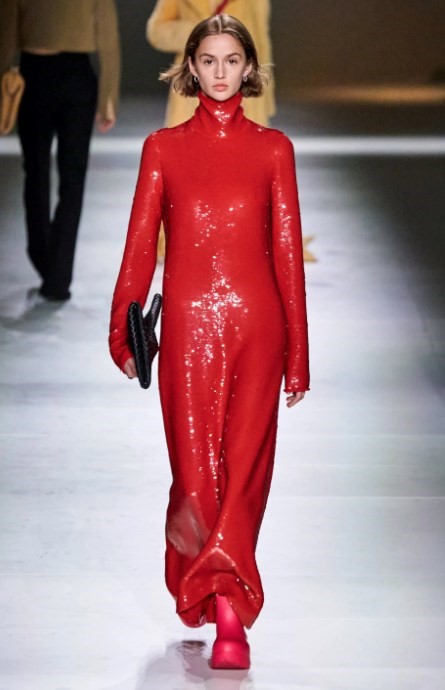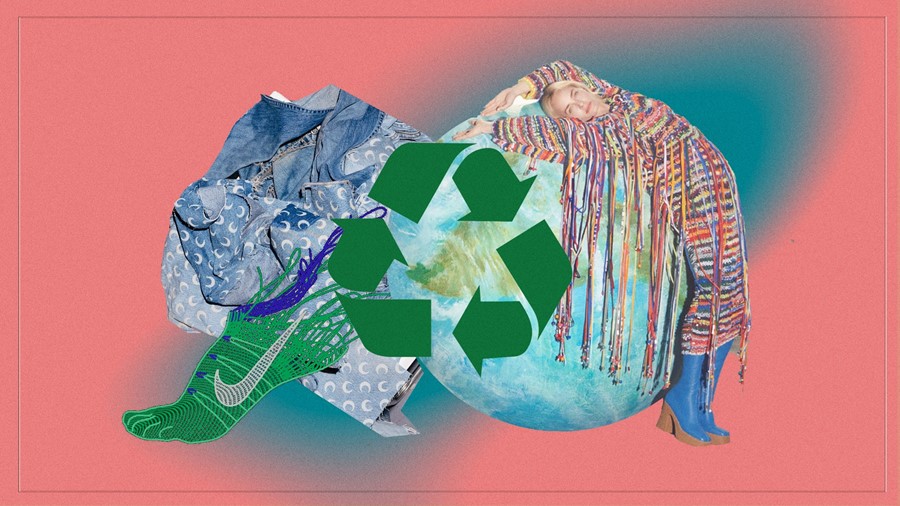Biodegradable fashion is gaining momentum among brands like Bottega Veneta and Stella McCartney. Clothes that don’t pollute sound great – but like any innovation, it deserves to be interrogated
Here’s an uncomfortable truth brands would rather we didn’t know: most clothes are destined to become trash. Yes, there are recycling schemes, but it’s estimated less than 1 per cent of clothes are recycled into new ones. Some garments are downcycled into mattress filling, but what happens to those mattresses when they’re worn out? Resale and upcycling may seem like obvious solutions, but when those clothes reach the end of their life or use, landfill is still a very likely final resting place. And if it’s not landfill, it’s a desert or a shoreline.
Faced with mounting evidence of the environmental and social impact clothes have when we decide we don’t want them anymore, some brands and designers are turning to biodegradability (the ability for something to be broken down biologically) as the solution, making apparel and footwear which will decompose into nothing when its discarded. The concept was peppered throughout the SS23 shows. Gabriela Hearst made shoes with biodegradable soles, Peter Do used TomTex, a biodegradable leather alternative, and the Coperni spray-on dress can, on request, be made from biodegradable fibres and binders. Back in 2020, Bottega Veneta debuted its 100 per cent biodegradable rubber boots, as Stella McCartney launched biodegradable stretch denim. Biodegradable fashion is certainly gaining momentum, and it sounds great – clothes that don’t pollute! – but like any innovation, it deserves to be interrogated.
Sophie Billi-Hardwick is co-founder of Billi London, a biodegradable tights brand. “I was late for work, was putting my tights on, they broke, and I shouted across the room a big ‘fuck’. And I went to my kitchen, threw my tights in the bin, and went and took another pair,” she says. “That's when I had my moment. It wasn't the fact that they ripped, it's the fact that I robotically threw them away and went to get another pair.”
In response to that, Billi London is a solution to the 7,000 tonnes of waste created by tights each year in the UK alone, explains Billi-Hardwick. An anomaly in the biodegradability game, Billi London tights are actually supposed to go in the bin because landfill provides the perfect, oxygen-free conditions for them to biodegrade into “biomass and biogas”. They are made from Amni Soul Eco, a nylon which will biodegrade in approximately five years, compared to the almost-100 years conventional tights take to break down. While the latter will break down into ever-smaller pieces of plastic, Billi-Hardwick says her tights will leave no microplastics in their wake.
KENT is perhaps closer to what you’d imagine when you think of biodegradability as the brand makes plant-based underwear. “Synthetics are a no go for us,” says founder Stacy Grace. “We can’t even use polyester thread. Every product we introduce to the market has to meet all our criteria to be compostable. We go through everything from materials, washes, dyes, and component parts to ease of compostability.”

The differences between KENT and Billi London highlight just how varied the biodegradable fashion landscape can be. Some items should go in the bin, some can be buried in your garden, others need specialist treatment. There’s no catch-all disposal method.
To ensure their products are truly compostable, KENT partnered with an LA composting facility. Results showed they break down in approximately 90 days, and act as a source of nutrients for the soil. Like Billi-Hardwick, Grace focused on items which aren’t likely candidates for being donated or resold at end-of-life, going as far as launching a compost club in partnership with a farm in late 2021. This made the circular system work even for people who don’t have access to it locally.
Of course, not all biodegradable fashion is high-rotation staples. It’s unlikely anyone will be chucking their Bottegas in the bin anytime soon, and yet “they will biodegrade within a year once placed underground, or in a controlled environment under specific lighting and humidity conditions alongside the presence of microorganisms.” Some might wonder what the point is, with some claiming that the ‘sustainable’ aspect of them being biodegradable is cancelled out by the fact that they’re made from sugarcane – meaning carbon-intensive shipping and the potential of resources being diverted from the food chain.
“There needs to be an end-of-life that’s less emissive, but we should really also look at the complete supply chain. I don’t want to be dismissive of biodegradability but I think it’s only one component of the really huge lifecycle of a product that we need to focus on” – William Theisen, EcoAct
Aniela Hoitink, CEO and founder of NEFFA and MycoTEX doesn’t face such materials issues because she uses mycelium, the root-like structure of fungi which can be grown at a large scale within lab or factory conditions. It’s an incredible material which can be formed around moulds using robots. During our video call, Hoitink showcases armour-like crop tops, chunky bracelets, and a host of textured fabrics in different colours. Aside from mycelium’s ability to become almost whatever the designer wants it to be, it will also break down in nature. “A lot of the garments end up in landfill, and if our garments end up in landfill this is better for nature,” says Hoitink. “The raw biomass from us is really compostable.”
However, Hoitink does not attempt to cover up the fact that some applications of her product require plastic coatings or chemical dyes which can affect its ability to biodegrade. “It can be that the brand [I’m manufacturing for] wants a specific colour and then we would need some chemical dyes. This is what makes it really difficult,” she explains. “We really are focusing on making it fully compostable, but it probably will be a long process by the time the pigment and coating companies are ready.”
Hoitink’s explanation underscores why you may see an article about a brand “working with a biodegradable material” but further digging reveals the final product is not biodegradable at all. Crucially, Hoitink doesn’t market biodegradability as MycoTEX’s best or leading property and is pragmatic about limitations, hoping brands will make choices that make the most of the material. But some brands play fast and loose with the term biodegradable leading to crackdowns on vague language. For instance, in France, Billi London cannot refer to its tights as being biodegradable because there’s so little precision around the term. Two different brands could refer to themselves as such, but one could sell a product which breaks down in three months and the other could sell a product which breaks down in 150 years.
It’s not particularly helpful for individuals trying to make responsible choices. Equally, nor is encouraging people to ditch their clothes or shoes at the earliest opportunity just because they won’t pollute the environment. For this reason, KENT follows the motto “wear slow, compost fast”, and Billi London shows its customers how to darn holes and turn worn out tights into plant hangers, ensuring long-term use before disposal to maximise resource use.
It’s inarguable that in some use cases biodegradability – coupled with repeated use – is a great solution, but can we pin all our hopes to it? “In the fashion industry brands have historically been more focused on social aspects than environmental aspects but now investors are really pushing them to measure their carbon footprint and look at their supply chain,” says William Theisen, CEO at climate consultancy EcoAct North America. “Biodegradability is one area that really resonates with consumers, but it may not actually be where most of the emissions are coming from.”
“There needs to be an end-of-life that’s less emissive, but we should really also look at the complete supply chain. I don’t want to be dismissive of biodegradability but I think it’s only one component of the really huge lifecycle of a product that we need to focus on,” Theisen continues.
It makes sense for brands solving specific problems, like huge numbers of tights and underwear going to landfill for lack of other options, to use biodegradability as their driving force, but like any sustainable solution, we should expect it as one of multiple measures.




